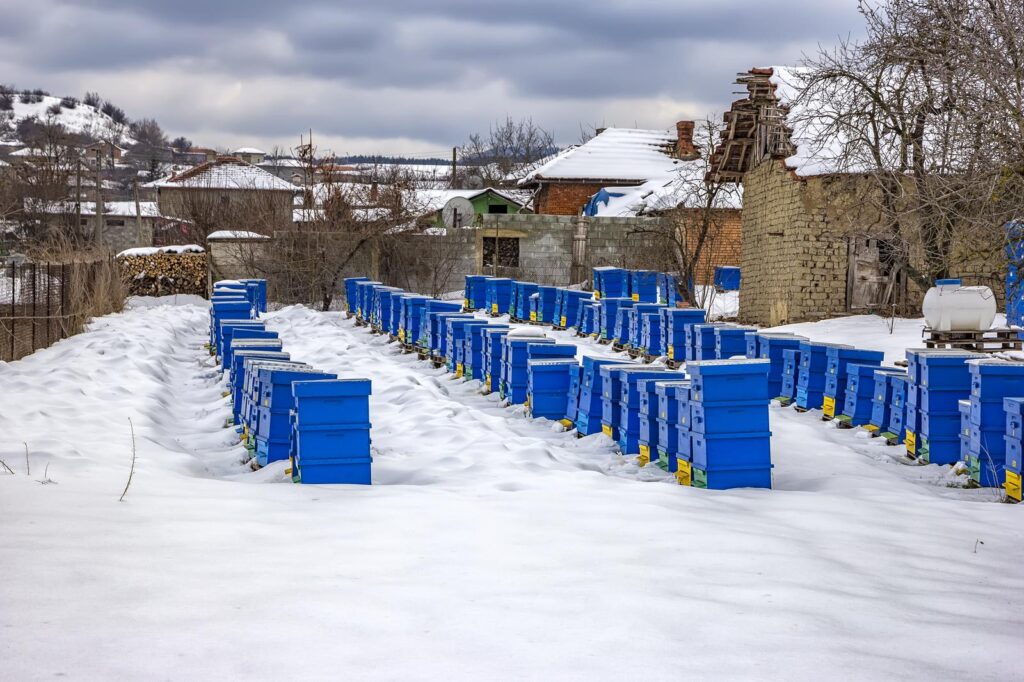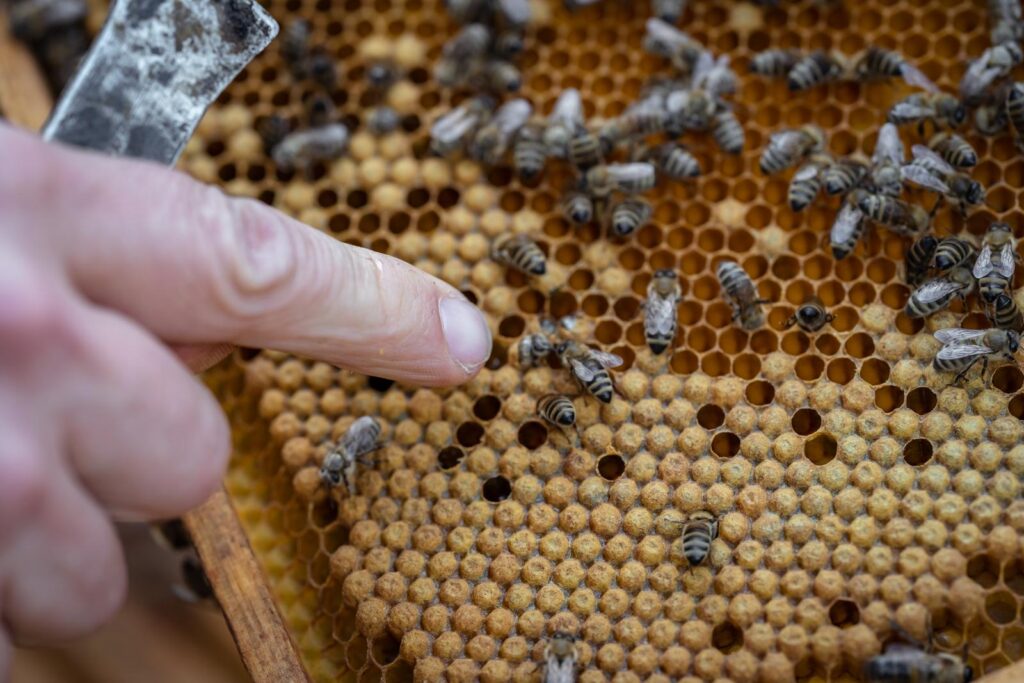Winter is finally here! I’m sure you would have set your wardrobe accordingly, all those coats and jackets will be out which you have wanted to style your outfits with, but did you know that bees also have to be prepared for winter and rainy season? This process of protection is called the Winterizing of beehives. In this blog post, I will tell you all about this process. So, stay tuned till the end.
Before we go into the details of winterizing, let me tell you that bees are a very clever part of our ecosystem. They do not hibernate like the rest of the animals, instead, they come together in clusters and stay together to retain the warmth and feed on the honey they have made earlier in the summer. To protect these colonies of bees, we have to follow the process called winterizing of bee hives.
Importance of Winterizing Beehives
Winterizing beehives is an essential part of beekeeping because it ensure the survival and health of bees during the harsh winter months. Bees face huge survival challenges during winter because not only the harsh cold can be lethal but also the food sources become scarce and even diseases can spread fast when they are confined to their hive during winter for most of the time.
Assessing Hive Health Before Start of Winter
Winterizing beehive starts even before actually doing it. The first step is to assess the present health status of your beehive. This process involves checking for common diseases, ensuring that beehive has a strong and healthy queen, and evaluating the population size of hive. Since a healthy hive is more likely to survive winter, it is recommended to seek detailed guidance on monitoring hive health from Bee Informed Partnership.
How can you winterize bee hives?
I would not be kidding if I were to tell you that this is a process that takes months! Yes, for 12 whole months, you have to prepare beforehand to make sure the hives are at an ideal temperature and not too heavy to fall back to the ground. Here is the step-by-step process on how to protect your precious honey-making cuties:
Feeding the hives:
The very first thing you must do before the break of the winter season is to feed the bees a special syrup. This syrup is made of 2 portions of powdered sugar and 1 portion of water. Since the winter will be starting by the time you do this process, there will be less nectar available for the bees, meaning that bees will have less food available.
An ideal place is to place this syrup high up in the hive to attract the bees to the topmost layer of its hive. This makes it easier for us to cover the bottom opening of the hive without any bees to bother. Another dilemma during this season is that bees usually steal this sugary syrup from the neighboring hives. Keeping the syrup high up in the hive prevents it from being stolen and the nectar taken to other hives.
Leave enough honey for the bees inside the hive:
Honeybees are known to eat a lot during cold weather, especially in colder regions of the world. It must be kept in mind that bees will feed on this honey for the rest of the winter season, therefore, it is better to keep enough honey for them to feed on as there will be no opening passage for the bees and they might starve. The Honey Bee Health Coalition offers excellent resources on feeding and nutrition (Honey Bee Health Coalition).
However, it must also be noted that every hive has a capacity to hold. Be careful to not place too much honey so the hive does not bear the weight and fall to the ground. On average, a hive eats about 60-90 pounds of honey every winter. It further depends on the size of the hive. In addition to this, the queen bees lay eggs once the winter is about to end.
This is the next generation of worker bees for the hive. The worker bees, on the other hand, shake their bodies to create heat for the hive. The weight of honey must be calculated and space must be left for all this activity to take place as well. Otherwise, the hive will fall to the ground and die.
Cover the beehive correctly:
Although this is an optional step, it is quite recommended for better results. Yes, I know it will add more to the weight of the hive, but it is a precautionary step. It prevents the hive from additional cold and moisture which are both not good for a healthy hive. The University of Minnesota Bee Lab provides useful insights into insulation and ventilation techniques (University of Minnesota Bee Lab)
Normally people cover it with newspapers or some thin layers which is definitely a risk as there are coats available in the market that are both water and cold-proof. If the hive is not covered, the outer layers of it might remain cold even if the center is not.
It will refrain the bees from moving to the food source and they might die in the hive, which is something nobody wants, right? The best option is to wrap the hive in some foam sheet which will act as a cold and moisture repellant.
Ensuring proper ventilation in the hive:
One of the side effects of either not using a cover for the hive or using a cheap, moisture-absorbing sheet is Nosema. This is a fungal disease found in hives that are not protected against the wet and chilly weather. In order to ensure proper ventilation, there must be two ⅜ inches holes in the bottom and top of the hive.
This will add to the cross ventilation and the moisture will not remain inside the hive. However, it must be kept in mind that the holes should not be bigger than this size or it may cause a cold temperature inside the hive.
Protect the entrance from Mice:
I know it sounds ridiculous but this is true. The defense mechanism of bees usually gets very slow during cold seasons. Mice, on the other hand, love to use this to their advantage.
Sometimes, when natural sheets are used to cover the bee hives, it might also attract mice to the openings of the hive. The best way to keep mice away from these pet bees is to either use mouse guards at all the entrances to the hives or to keep the ventilating holes small so that only the bees can move to and pro but mice can not.
Treat Varroa Mites on time:
Even if you have taken good care of your bees, if you fail to treat Varroa mites or other pests on time, all your hard work will go to waste. As the name sounds, these mites are very dangerous for our bee colonies. These mites feed on the larvae that were freshly laid by the queen bee which means that the coming generation of worker bees will be deformed.
Once the larvae harden their shells and form eggs, these mites start feeding on the worker bee colonies. This results in a major loss in the bee population which is not good for bee harvesters as well as the hive. The American Bee Journal is a reliable source for information on pest and disease control (American Bee Journal).
Reducing Disturbances:
It is important that bees are not disturbed unnecessarily during winter. Bees are intelligent and forma cluster to keep bee queen and themselves warm during cold. This protection from cluster will be reduced with frequent disturbances, leading to a temperature drop that could potentially harm the bees.
Monitoring Throughout the Winter:
Even though disturbances should be minimized but at the same time it is still necessary to closely monitor hive. It can be done by regularly checking weight of the beehive to get an idea of food consumption. Now technology is also available to help with tracking temperature and humidity levels of hive. The National Honey Board offers insights into winter hive monitoring (National Honey Board).
Wintering beehives is a critical aspect of beekeeping, which requires careful planning and its implementation. The chances of survival of bee colonies can be significantly improved by carefully focusing on overall hive health, ensuring bee nutrition during winter, insulation of beehive, pest control and reducing disturbances.
This guide is only a starting point but you must know that beekeeping involves continuous learning. Each hive and its location might require adaptation of approaches, so, keep learning, stay adaptable and keep regular contact with beekeeping community for shared advice and experiences of other beekeepers. Here’s to healthy, thriving hives coming spring!
As easy as it seems, beekeeping is as daunting a task. It requires a lot of precision and care. One has to be vigilant at all times and get prepared for things months before the arrival of the winter season. I hope you found this article informative. Stay tuned for more blogs that will contribute to the knowledge of beekeeping!
I have also written about insulating beehives and mouse guards for hives. You may also like to check these write ups.


